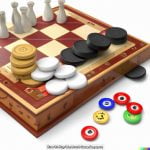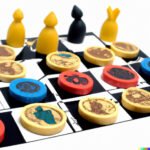Are you looking for a fun and engaging board game to play with friends and family? Look no further than Sequence Classic Board Game. This beloved game combines the excitement of card games with the strategy of traditional board games, making it a perfect choice for game nights and gatherings. In this article, we’ll take a closer look at the history, rules, variations, and enduring popularity of Sequence Classic Board Game.
The history of Sequence traces back to its invention and evolution into a classic game that has stood the test of time. From its humble beginnings to its rise in popularity, Sequence has become a staple in many households and social gatherings. Understanding its roots can deepen our appreciation for this timeless game.
Learning how to play Sequence is essential for anyone looking to enjoy the game to its fullest. From setting up the board to understanding the gameplay mechanics, mastering the rules and strategies is key to becoming a formidable opponent. Whether you’re new to the game or a seasoned player, this section will provide valuable insights into playing Sequence like a pro.
The History of Sequence
Sequence is a classic board game that has stood the test of time, captivating players with its unique combination of strategy and luck. The history of Sequence dates back to 1982 when Doug Reuter, a graduate of the University of Washington, invented the game. What started as a family pastime quickly gained popularity, eventually becoming a beloved classic in the world of board games.
The inspiration for Sequence came from two traditional games, Solitaire and Jacks. By combining elements of these games with a standard deck of playing cards, Reuter created a new and exciting game that appealed to people of all ages. His invention was met with enthusiasm and quickly gained traction, thanks to its simple yet engaging gameplay.
After Reuter patented the game in 1981, Sequence was officially launched in 1982. Since then, it has become a staple in many households around the world. Its enduring appeal lies in its accessibility and versatility, making it an ideal choice for casual gatherings or competitive play.
| Year | Event |
|---|---|
| 1981 | Doug Reuter patents Sequence |
| 1982 | Sequence is officially launched |
How to Play Sequence
Sequence is a classic board game that combines elements of strategy and luck. The game can be played with 2-12 players, either individually or in teams. The objective of the game is to create rows of five poker chips on the board by matching the cards in your hand to the spaces on the board. Here is a basic overview of how to play Sequence:
Rules:
- The board consists of a 10×10 grid, each square representing a playing card (except for jacks), and two corner squares.
- Players or teams take turns drawing a card from the deck and playing it on the corresponding space on the board.
- The goal is to get five chips in a row horizontally, vertically, or diagonally.
- Special cards allow players to remove their opponent’s chips or place their own chip on an open space.
Setup:
- Place the game board on a flat surface within reach of all players.
- Divide players into teams, if playing with more than two people.
- Each player or team selects a colored set of poker chips and places them within reach.
- Shuffle the deck of playing cards and deal a specific number of cards to each player, depending on how many are playing.
Gameplay:
Each turn consists of drawing a card from the deck and then placing one of your poker chips on the corresponding space on the board. Strategy comes into play as you try to block your opponents while setting yourself up for victory. The game continues until one player or team achieves two sequences.
Learning how to play Sequence is easy, making it accessible for players of all skill levels. Whether you’re new to board games or looking for a fun activity for game night, Sequence offers engaging gameplay that will keep you coming back for more.
Strategy Tips for Winning at Sequence
When it comes to the strategy for winning at Sequence, there are a few key tips that can help players improve their chances of coming out on top. One important strategy is to focus on building multiple sequences at once.
Since a player only needs to complete two sequences to win the game, working on multiple sequences simultaneously can increase the chances of success. This involves paying attention to the cards in hand and the board, and strategically placing chips to build towards different sequences.
Another effective strategy for winning at Sequence is to pay close attention to blocking opponents. By placing a chip on a space that prevents an opponent from completing a sequence, players can slow down their progress and give themselves an advantage. This can be especially useful when an opponent is close to completing a sequence, as it forces them to invest more turns into achieving their goal.
Finally, it’s essential for players to carefully manage their wild cards. Wild cards can be used as versatile tools for creating or completing sequences, so holding onto them until they are most advantageous is crucial for success in Sequence. By being strategic with the use of wild cards and maximizing their potential impact on gameplay, players can greatly increase their chances of winning the game.
Sequence Variations
Sequence is a classic board game that has been enjoyed by families and friends for decades. While the classic game itself is entertaining and strategic, there are also several variations that add new twists and challenges to the gameplay. These variations can provide a refreshing change for those who have mastered the original game or are looking for something new to try.
Some popular variations of Sequence include:
– **Sequence Dice:** This variation replaces the cards with dice, adding an element of chance to the game. Players roll the dice to form sequences on the board, making it a more luck-based version of the original game.
– **Giant Sequence:** For those who prefer a larger-than-life gaming experience, Giant Sequence features a jumbo-sized board and playing pieces, creating a whole new dynamic to the gameplay.
– **Kids’ Sequence:** This kid-friendly version of the game incorporates colorful animal illustrations on the board and cards, making it more appealing and accessible to younger players.
Whether you’re looking for a more unpredictable experience with Sequence Dice, an oversized version of the game with Giant Sequence, or a child-friendly option with Kids’ Sequence, these variations offer something different for players of all ages. Trying out these alternative versions can breathe new life into your gaming nights and keep the fun going for years to come.
The Social Aspect of Sequence
Sequence is not only a game of strategy and skill, but it also excels as a social activity that brings people together. Whether it’s a family gathering, a party with friends, or a casual game night, Sequence is the perfect choice for group entertainment.
Building Camaraderie and Connection
Playing Sequence in groups fosters camaraderie and strengthens social connections among players. The game provides opportunities for friendly competition, teamwork, and cooperation as players strategize and communicate with each other to achieve victory. Additionally, the element of chance in the game adds an exciting and unpredictable aspect to the gameplay, keeping everyone engaged and creating memorable moments.
Fun for All Ages
One of the best things about Sequence is its universal appeal across different age groups. Whether young or old, people can easily learn and enjoy playing this board game. This makes it an ideal choice for gatherings where there are participants of varying ages, ensuring that everyone can partake in the fun without feeling left out.
Enhancing Communication Skills
Sequence encourages interaction between players, allowing them to engage in conversations while participating in the game. This promotes better communication skills among individuals as they discuss their strategies and moves with their teammates or opponents. The game creates a lively atmosphere filled with laughter and excitement, making it an excellent icebreaker for bringing people closer together.
Sequence Classic Board Game
Sequence is not just any board game; it is a must-have for game night. Whether you are gathering with friends, family, or both, Sequence has the ability to entertain and engage players of all ages.
Engaging Gameplay
One of the reasons why Sequence is a staple for game nights is its engaging gameplay. Players strategize, form teams, and compete to be the first to complete a sequence of five chips in a row on the board. The mix of strategy and luck keeps the game exciting and ensures that each round is different from the last.
Suitable for All Ages
Another reason why Sequence is perfect for game night is that it is suitable for players of all ages. The rules are easy to grasp, making it accessible to children, while the strategic aspects keep adults challenged and entertained. This inclusivity makes Sequence an ideal choice for a mixed-age group of players.
Accessible and Affordable
Sequence’s accessibility and affordability also make it an essential addition to any game night collection. The game can be purchased at an affordable price point, making it an accessible option for many households. Additionally, its simple setup and minimal components make it easy to bring out and set up for a fun evening of gameplay.
The Enduring Popularity of Sequence
In conclusion, Sequence Classic Board Game has stood the test of time and remained a favorite among both casual gamers and seasoned board game enthusiasts. Its enduring popularity can be attributed to a combination of factors, including its simple yet engaging gameplay, strategic depth, and social aspect. The game’s history, from its invention to achieving classic status, speaks to its undeniable appeal and staying power.
One reason for the continued success of Sequence is its accessibility. The rules are easy to understand, making it suitable for players of all ages and skill levels. However, the game also offers enough strategic depth to keep more experienced gamers engaged, striking a balance that few other games have achieved. This versatility has undoubtedly contributed to its longevity in the world of board gaming.
Furthermore, the social aspect of Sequence cannot be overlooked. The game’s ability to accommodate larger groups makes it an ideal choice for gatherings and game nights. Whether played with family or friends, Sequence fosters an atmosphere of friendly competition and camaraderie.
It is this combination of accessibility, strategy, and sociability that ensures Sequence remains a beloved classic after decades since its inception. With these qualities in mind, it’s clear why Sequence Classic Board Game is still a must-have for any game night repertoire today.
Frequently Asked Questions
What Age Is Sequence Classic For?
Sequence Classic is suitable for ages 7 and up. The game involves a mix of strategy and luck, making it engaging for both children and adults alike.
What Are the Different Versions of Sequence Board Game?
There are several different versions of the Sequence board game, including Sequence for Kids, Travel Sequence, Jumbo Sequence, and even a dice version called Roll Through the Ages: The Bronze Age. Each version offers a unique twist on the original game, catering to different preferences and age groups.
Is Sequence an Old Game?
Sequence is not an incredibly old game, but it was first published in 1982. Despite not having centuries of history like some classic games, Sequence has gained popularity over the years and has become a beloved staple in many households. Its simple yet addictive gameplay ensures its continued relevance in the world of board games.

I love playing all kinds of games – from classics like Monopoly to modern favourites like Ticket to Ride.
I created this blog as a way to share my love of board games with others, and provide information on the latest releases and news in the industry.





